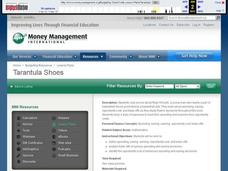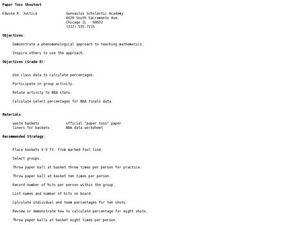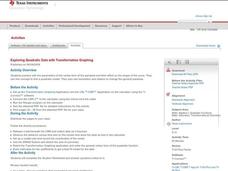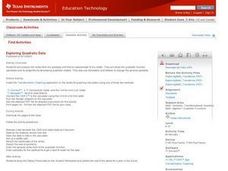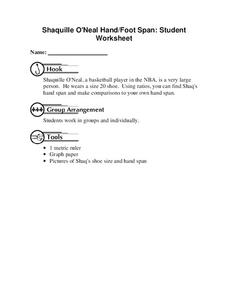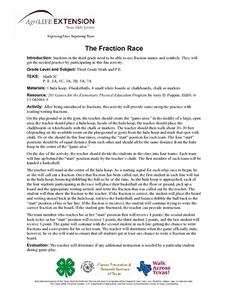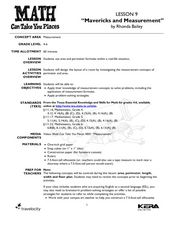Curated OER
Badminton or Basketball?
Students explain why for a group of n people, there are an equal number of possibilities for subgroups of size k (such that k < n) and size n - k.
Curated OER
Swish: Applying Statistics to Real Life
Sixth graders conduct on-line research of shot data and percentages for professional basketball players. They compare computed data to researched data and write a letter informing professional organizations of their findings.
Curated OER
Fruit Loops/Cheerios Activity: Measures of Central Tendency
In this measures of central tendency worksheet, students use Fruit Loops and Cheerios to gather statistical data. They find the mean, mode and median of the data. Students construct a box-and-whisker plot of the class data. This...
Curated OER
Shaquille O'Neal: Foot and Hand Size
In this measurement worksheet, students will cut out and compare their own feet and hands to that of basketball star, Shaquille O'Neal.
Curated OER
Shaquille O'Neal Hand & Foot Span
If Shaquille O'Neal wears a size-20 shoe, how big are his hands? Learners will use the average ratios of foot length to hand span to calculate the hand span of Shaq, but first, they have to collect the data! They will...
Curated OER
Dribbling Math Challenge
Students practice foot dribbling and hand dribbling with control. In addition it helps to reinforce math concepts.
Curated OER
Max's Math Adventures
In these shape activity worksheets, students read the poem about shapes and then draw and write about one of the zoo animals from the zoo. Students use the given shapes to put their animal together. Students add hair, eye color, and...
Virginia Department of Education
z-Scores
Just how far away from the mean is the data point? Pupils calculate the standard deviation for a set of data and find out how many standard deviations a point is away from the mean. The teacher leads a discussion on how to calculate...
Curated OER
Tarantula Shoes
Students read a book about Ryan O'Keefe, a young man who wants a pair of basketball shoes promoted by a basketball star. They explore about spending, saving, opportunity cost, and trade-offs as they study Ryan's decisions throughout the...
Curated OER
Measuring Up on the Mayflower
Second graders use a meter tape to compare the length of the Mayflower to a basketball court and make homemade butter for crackers. Afterward, all students sit inside the makeshift Mayflower's dimensions and enjoy their Pilgrim butter.
Curated OER
Triangles
Fourth graders participate in three experiments to gain understanding of triangles. In this triangles lesson, 4th graders use pipe cleaners to create bubble pipes, basketball hoops and bingo cards to display the characteristics of...
Curated OER
Science of Special Effects
This is a creative, multidisciplinary, well-designed lesson provided by Scientific American related to special effects. Young scholars make their own animated short films and use math and computer skills.
Curated OER
What's My Pattern?
Students recognize, describe and extend patterns in three activities. They organize data, find patterns and describe the rule for the pattern as well as use the graphing calculator to graph the data to make and test predictions. In the...
Curated OER
Paper Toss Shootout
Students explore the concept of percentages. In this math lesson, students throw paper at wastebaskets as if shooting a basketball in a hoop. Students shoot the paper a given amount of times and then calculate their shooting percentage....
Curated OER
Exploring Quadratic Data with Transformation Graphing
Using a data collection device to collect data regarding a bouncing ball, students use various features on graphing calculators to experiment with the parameters of the vertex form of the parabola and their effect on the shape of the...
Curated OER
Exploring Quadratic Data : Transformation Graphing
High schoolers analyze the vertex form of a parabola and find an approximate fit of a model. They explain the quadratic parabola function and its properties by developing quadratic models. They use translation and dilation to change the...
Curated OER
Let's Play Some Ball!
Pupils review horizontal and vertical shifts of a parabola and how they effect a specific quadratic formula. They play a basketball review game in which they try to find the right quadratic equation for a given problem in order to earn...
Curated OER
Shaquille O'Neal Hand/Foot Span
Shaquille O'Neal has huge hands and feet, and learners will use those two measurements to practice collecting and extrapolating data using ratios. They record the measurement of foot and hand span of several of their classmates, then...
Curated OER
Understanding Proportions and Scale Drawings
Proportions are ratios found using multiplication or division. Middle schoolers solve measurement problems, find a figure's missing dimension, and find the distance between two points. Resource features four lesson plans with detailed...
Curated OER
Basketball Caps
Students work on a problem, individually or in pairs. They are asked questions that focus on average. They discus that the average number represents an equal redistribution , rather than just being able to state the rule. They write...
Curated OER
The Fraction Race
The students participate in a game involving a hula hoop and basketballs. After each student participates in the activity, they write their game score in fraction form using the points they earned over the points possible.
Curated OER
Mavericks and Measurement
Learners study the measurement formulas for area and perimeter in real-life situations. In this area and perimeter lesson, students design a bed and arrange furniture in a hotel room using area and perimeter formulas for a 7 1/2 foot...
Curated OER
Millions, Billions, Trillions
Young scholars use real-world data to compare the relative sizes of millions and billions, and exponential growth. They use the salaries of famous people such as, Michael Jordan and Bill Gates to understand this math concept.
Curated OER
The Distributive Property
Students use a visual to introduce the Distributive Property. The lesson is chronologically numbered and follows a distinct plan. The class works with the teacher to complete the lesson. The plan is not written in a traditional way, but...










